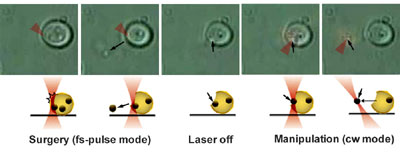18 November 2008. Quezon City, Philippines. A collaborative research venture between the Philippines and Japan has shown that a single laser can be used to manipulate and perform microsurgery on cells. They manipulate cells using the principle of optical trapping where gradient forces of light attracts the cells towards the focus. By moving the focus of the beam using scanning mirrors, the optically trapped yeast cells are manipulated around the microscopic region of interest. On the other hand, dissecting the cells is achieved via non-linear optical absorption process. The team showed that a single Ti:Sapphire laser, which can be switched between continuous-wave (cw) and femtosecond (fs) pulse mode, can be used for both functions1.
 |
| Research team: Jun Ando, Nicholas Smith and Katsumasa Fujita (Osaka University, Japan); Godofredo Bautista and Vincent Daria (National Institute of Physics, UP Diliman, Philippines) |
The research team is composed of Jun Ando, Nicholas Smith, Katsumasa Fujita, Godofredo Bautista and Vincent Daria. They have shown that the cw-mode of the laser is able to non-invasively trap and manipulate the cells. They also showed that the energy of the near-infrared Ti:S laser (780-nm-wavelength) is not enough to induce damage as proven by uninterrupted growth of the cells. For non-invasive optical trapping of living biological tissues, the energy of the laser should be low enough so light is not absorbed and does not initiate damage on the cells. Lasers operating in the near-infrared (NIR) region are minimally absorbed by biological tissues.
Performing optical surgery, on the other hand, requires a high energy ultra-violet (UV) laser, which is in the other end of the light spectrum. Single-photon absorption of UV light allows for significant damage on the biological tissues. Hence, previous techniques make use of two complementary lasers coupled into the system to perform optical trapping and surgery. In their recent work, they show that using a single ultrafast (femtosecond) Ti:S laser combines both functionalities. Optical surgery is achieved when operating the laser in fs-pulse mode, with the principle associated to multi-photon ionization and non-linear absorption on the cell walls. By changing the operational mode of the laser from cw to fs-pulse mode, they can selectively perform trapping or surgery, respectively.
 |
| Sequential images showing optical surgery and manipulation to extract organelles from a yeast cell. |
They performed experiments demonstrating extraction of cell organelles using the combined technique of laser surgery and trapping. The figure above shows sequential bright field images of extraction and manipulation of yeast cell organelles. Optical surgery was done with the Ti:S laser in femtosecond-pulse mode focused on the cell wall. Dissection resulted in efflux of organelles from the cell. By changing to cw-mode, a single intracellular organelle was successfully manipulated and extracted through the area of the cell wall dissected by laser irradiation.
Their work was done at the National Institute of Physics, University of the Philippines (UP) as part of the student exchange program between UP and Osaka University (OU), Japan. The exchange program between OU and UP was first initiated by Prof. Satoshi Kawata (OU) and Prof. Caesar Saloma (UP) in 1996. Since then several researchers between the two universities have been part of the exchange program. The use of the ultrafast laser for optical manipulation and non-linear optical absorption has been part of V Daria’s research grant from the Philippine Council for Advanced Science and Technology Research and Development (PCASTRD), Department of Science and Technology (DOST). J Ando’s visit to the Philippines was funded by the Japan Student Services Organization (JASSO). Since the publication of their paper, their work has been featured by the Institute of Physics (UK)2 and selected to be indexed at virtual journals of the American Physical Society and American Institute of Physics.3-4 Virtual journals are edited compilations of links to articles from participating publishers, covering a focused area of frontier research.
References
1. J Ando, G Bautista, N Smith, K Fujita and VR Daria, Optical trapping and surgery of living yeast cells using a single laser, Rev of Sci Instr 79. p103705 (2008)
2. M Freebody, “Single laser traps and dissects cells, ” www.optics.org
3. Virtual Journal of Biological Research, November 2008 Issue
4. Virtual Journal of Ultrafast Science, November 2008 Issue